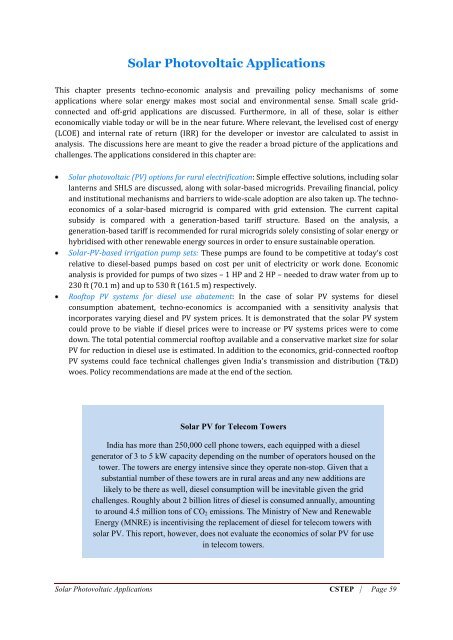Harnessing Solar energy, Options for India
A study on harnessing solar energy options for India was conducted recently by Shakti Sustainable Energy Foundation, Climate works Foundation and SSN foundation. Supporting this study it has been concluded that solar energy can play a big role in providing electricity to rural areas and thus has been included in India’s rural electrification policy. See more at: http://shaktifoundation.in/report/harnessing-solar-energy-options-for-india/
A study on harnessing solar energy options for India was conducted recently by Shakti Sustainable Energy Foundation, Climate works Foundation and SSN foundation. Supporting this study it has been concluded that solar energy can play a big role in providing electricity to rural areas and thus has been included in India’s rural electrification policy. See more at: http://shaktifoundation.in/report/harnessing-solar-energy-options-for-india/
Create successful ePaper yourself
Turn your PDF publications into a flip-book with our unique Google optimized e-Paper software.
<strong>Solar</strong> Photovoltaic Applications<br />
This chapter presents techno-economic analysis and prevailing policy mechanisms of some<br />
applications where solar <strong>energy</strong> makes most social and environmental sense. Small scale gridconnected<br />
and off-grid applications are discussed. Furthermore, in all of these, solar is either<br />
economically viable today or will be in the near future. Where relevant, the levelised cost of <strong>energy</strong><br />
(LCOE) and internal rate of return (IRR) <strong>for</strong> the developer or investor are calculated to assist in<br />
analysis. The discussions here are meant to give the reader a broad picture of the applications and<br />
challenges. The applications considered in this chapter are:<br />
<strong>Solar</strong> photovoltaic (PV) options <strong>for</strong> rural electrification: Simple effective solutions, including solar<br />
lanterns and SHLS are discussed, along with solar-based microgrids. Prevailing financial, policy<br />
and institutional mechanisms and barriers to wide-scale adoption are also taken up. The technoeconomics<br />
of a solar-based microgrid is compared with grid extension. The current capital<br />
subsidy is compared with a generation-based tariff structure. Based on the analysis, a<br />
generation-based tariff is recommended <strong>for</strong> rural microgrids solely consisting of solar <strong>energy</strong> or<br />
hybridised with other renewable <strong>energy</strong> sources in order to ensure sustainable operation.<br />
<strong>Solar</strong>-PV-based irrigation pump sets: These pumps are found to be competitive at today’s cost<br />
relative to diesel-based pumps based on cost per unit of electricity or work done. Economic<br />
analysis is provided <strong>for</strong> pumps of two sizes – 1 HP and 2 HP – needed to draw water from up to<br />
230 ft (70.1 m) and up to 530 ft (161.5 m) respectively.<br />
Rooftop PV systems <strong>for</strong> diesel use abatement: In the case of solar PV systems <strong>for</strong> diesel<br />
consumption abatement, techno-economics is accompanied with a sensitivity analysis that<br />
incorporates varying diesel and PV system prices. It is demonstrated that the solar PV system<br />
could prove to be viable if diesel prices were to increase or PV systems prices were to come<br />
down. The total potential commercial rooftop available and a conservative market size <strong>for</strong> solar<br />
PV <strong>for</strong> reduction in diesel use is estimated. In addition to the economics, grid-connected rooftop<br />
PV systems could face technical challenges given <strong>India</strong>’s transmission and distribution (T&D)<br />
woes. Policy recommendations are made at the end of the section.<br />
<strong>Solar</strong> PV <strong>for</strong> Telecom Towers<br />
<strong>India</strong> has more than 250,000 cell phone towers, each equipped with a diesel<br />
generator of 3 to 5 kW capacity depending on the number of operators housed on the<br />
tower. The towers are <strong>energy</strong> intensive since they operate non-stop. Given that a<br />
substantial number of these towers are in rural areas and any new additions are<br />
likely to be there as well, diesel consumption will be inevitable given the grid<br />
challenges. Roughly about 2 billion litres of diesel is consumed annually, amounting<br />
to around 4.5 million tons of CO 2 emissions. The Ministry of New and Renewable<br />
Energy (MNRE) is incentivising the replacement of diesel <strong>for</strong> telecom towers with<br />
solar PV. This report, however, does not evaluate the economics of solar PV <strong>for</strong> use<br />
in telecom towers.<br />
<strong>Solar</strong> Photovoltaic Applications CSTEP | Page 59

















